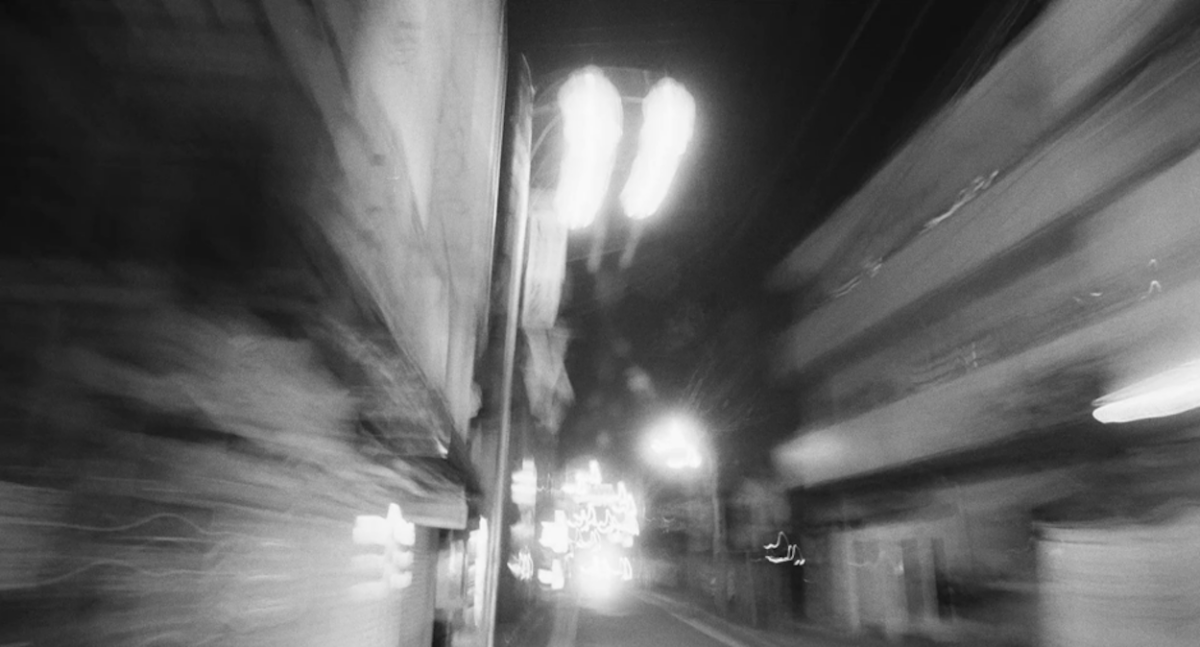Everything is just swirling around me in circles — The Rockers, Cell No. 8
My head’s always at the limit — BUCK-TICK, Speed
DREAMER, DREAMER, Don’t hesitate, Charge ahead, block the road — 44magnum, No Standing Still
SPEED FREAKS BABY ROCKET DIVE, […] SPACE AGE BABY ROCKET DIVE — hide with Spread Beaver, Rocket Dive
I. His Motorbike, Their City
In 1958 Nagisa Oshima proclaimed that the advent of a new, modernist generation of filmmakers had come with Ko Nakahira’s Crazed Fruit (1956), “in the rip of a woman’s skirt and the buzz of a motorboat”. About 20 years later, the taiyōzoku (sun-tribe) youth depicted in Nakahira’s films had been replaced by a new set of prime-delinquents, the bōsōzoku (the out-of-control or the violent-driving tribe), and the motorboat had become the customised motorcycle.
Motorcycle gangs had existed in Japan ever since the 50s and the bōsōzoku were actually preceded by the slightly tamer, more hippie and more middle-class kaminarizoku (the thunder tribe), as initially only the wealthier youth could afford a motorbike. By 1980, Japanese cinema had already taken a liking to bikers, most notably through the studios’ ventures into exploitation and juvenile delinquency films such as Toei’s Bakuhatsu! series and Nikkatsu’s Stray Cat Rock series, the latter also featuring an early-career Meiko Kaji. Even throughout the 50s the motorcycle had been perceived as somewhat of a symbol for a rebellious generation of youngsters — in the same text from 1958‘Is It a Breakthrough? (The Modernists of Japanese Film)’, Film Review, July 1958, as quoted in Cinema, Censorship, and the State: The Writings of Nagisa Oshima 1956-1978, Nagisa Oshima, Annette Michelson (ed.), The MIT Press, 1992. Oshima was particularly laudatory at the fresh approach offered by the motorcycle scene in Yasuzo Masumura’s Kisses (1957).
During the 70s the bōsōzoku had become a media phenomenon, with the news constantly warning against these delinquents and exaggerating their potential danger, often suggesting they were an entry point into the yakuza, a consideration which might not have been true. One essential document of the bōsōzoku way of life and a more truthful portrayal of the subculture was Mitsuo Yanagimachi’s low-budget documentary, God Speed You! Black Emperor (1976), which followed a real-life gang, the Black Emperor. Yanagimachi accentuated a certain communal kinship and depicted the bōsōzoku as aimless and struggling youngsters from the lower classes, who found freedom in punk music and a shared love (or perhaps need) for disruption, motorcycles and speed. Black Emperor examined fragments of the bōsōzokus’ personal lives and the reasons for which they might have been driven to join their gangs, but its grainy cinema verité style, punk music montages and headlamps beaming into the camera also provided an aesthetic cue for what would follow with a new generation of self-produced and independent filmmakers.
As the Japanese New Wave had almost waned, it was time for punk to set in as the new form of cinematic rebellion, and so the early 80s saw the release of perhaps the two most famous bōsōzoku films ever made, Gakuryū (formerly Sogo) Ishii’s Crazy Thunder Road (1980) and Burst City (1982). The revving engines in Ishii’s films went much further than the studio films’, they came with a literal kinetic charge sustained by frenzied editing and a mode of agitated, guerilla-like punk filmmaking where almost nothing ever stood still.
The bōsōzoku themselves were influenced by punk and in fact much different from their predecessors, in that they sought more active disruption, even if rarely in a political sense. They were keener to antagonise the authorities than to overthrow them, ‘terrorising’ the roads and the highways. These young and loud bikers turned their late-night cruising and racing into something akin to a life philosophy. Speed and thrills became principles, used either to escape from a state of accumulated frustration at society or to channel it through driving. Always on the move, these daredevil drifters were also drifters in a Benjaminian sense, engaging in a kind of detached but not idle exploration of the city that allowed them to reject participation in society and to reclaim the streets for themselves.
With the bōsōzoku reaching the heights of popularity throughout the 70s and early 80s, their existence also marked a new way of interacting with the city as a space that was getting increasingly more technologised and urbanised as society went further into the Digital Age. A new understanding of urban environments was popular all around the world: a film like the neo-city symphony Koyaanisqatsi (1982) speculated on the images of the modern city as a fast-paced, technology-dependent and flashy environment, and accentuated that notion through its timelapse montages. Crucially, however, by this time Japan had already become one of the world’s most important exporters of electronics, which deepend the country’s relationship with technology and urbanism on a very different levelThe 90’s were, however, an even more important period in this regard, and a decade that further consolidated, in popular terms, Japan’s image as a technological, electronic and digital wonderland.. To resort to a poetic exaggeration, the modern city — now the metropolis — had become navigable only through vehicles and owning a motorcycle seemed like the last bit of freedom one could have in this new urban paradigm.
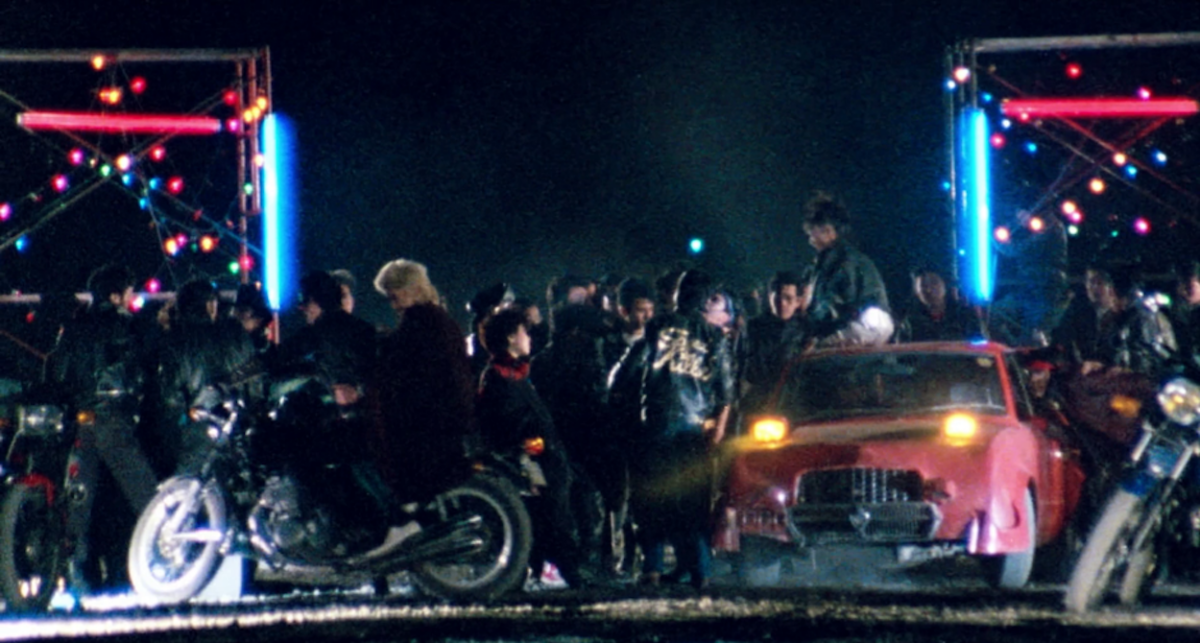
While it depicted some ample cruising scenes, Ishii’s Crazy Thunder Road was more centred on the dynamics between rival gangs and laid only the groundwork for the even more frenzied experimentation that followed with Burst City. In-between, there was a short, Shuffle (1981, based on a story by none other than Katsuhiro Otomo), that anticipated the director’s affinity for a visual language obsessed with erratic, hypnotic speed and movement. Burst City, Ishii’s third feature (and actually the first film he made while not at university), was more interested in the modern reconfiguration of the city and modern life, but also in the new anxieties industrialization and urbanisation had created, materialised through jarring montages and individuals on the brink of aggressive explosion. The film’s dystopian tone, heavily mechanised society, DIY steel gear, and modified outfits set the plane for the birth of Japanese cyberpunk and went on to influence other iconic landmarks of the genre, including Katsuhiro Otomo’s Akira (1988) and Shinya Tsukamoto’s Tetsuo: The Iron Man (1989). It also set the tone for Ishii as a director whose main mode of interacting with the city has been running through the streets, either to escape from something or to amuse oneself, in flow-like mental states.
II. Street Noise
For Ishii, speed and images of fast traffic are the default devices for exploring and describing modern urban space. Burst City begins with one of the director’s visual trademarks, a montage of undercranked footage that depicts travelling through the streets, seemingly from the point of view of a motorcycle fork. The lights blur into luminous trails until they become almost like structuralist flickers, dancing erratically on the screen with space turning abstract and the streets becoming unrecognisable. These blurred traces of light return all throughout the film in moments of fervour, often accompanied by an unsteady camera.
On the one hand, this kind of accelerated reality seeks to induce an altered psychological state, replicating the thrill that the bōsōzoku were after. Presumably, this is how you’d be experiencing the city if you were pushing it to the limits — or, alternatively, if you were high on drugs, like a good delinquent. In comparison, Crazy Thunder Road did emphasise speed as a culture by featuring kinetic montages of road charges and breezing past city outskirts and neon lights, but it wasn’t trying to emulate a state of mind per se. Ishii’s second feature spent much time on motifs of spinning wheels and images of the city going blurry as its greaser-punks were out on the road, yet these were generally seen from the outside, and not from a profoundly subjective, ‘inside-the-mind’ point of view. The idea of a flow-like vantage point is further reinforced in Burst City when the shots from the opening montage return throughout the film, most notably in a moment where one character seems to be hallucinating.
On the other hand, the abnormal speed in Burst City’s intro has an almost non-human quality to it, a suggestion enhanced by the partly dreamlike, partly uncanny music and muddy sound in the sequence. To tie it in with the film’s cyberpunk flair, these trails of light might look closer to how hyperspace is usually represented — or, if you will, they could emulate just how fast information might be travelling through the optical fibres of the Digital Age. Technology and modernity are, after all, about being fast. If for Burst City this conclusion could run the risk of over interpretation, Ishii is keener to underline a direct link between electricity and speed in his 2001 return to punk aesthetics, Electric Dragon 80.000 V. As Tadanobu Asano’s Dragon Eye Morrison charges, pardon the pun, ragefully through the streets, graphic streaks of lightning appear and disappear on the screen, accentuating his superhuman characteristics and the aggression of his speed. One other montage in the film is even more explicit. With Thunderbolt Buddha’s moving around the city it’s not speed but his buddha-like serene slowness that is accentuated, the antagonist’s calculated pace also advertising a certain digital, electronic feel. The scene crosscuts between a tracking shot of the electrician vigilante and images of electrical cables and digital screens whose flickers go into the same direction, creating a simple but telling association about his superhuman nature.
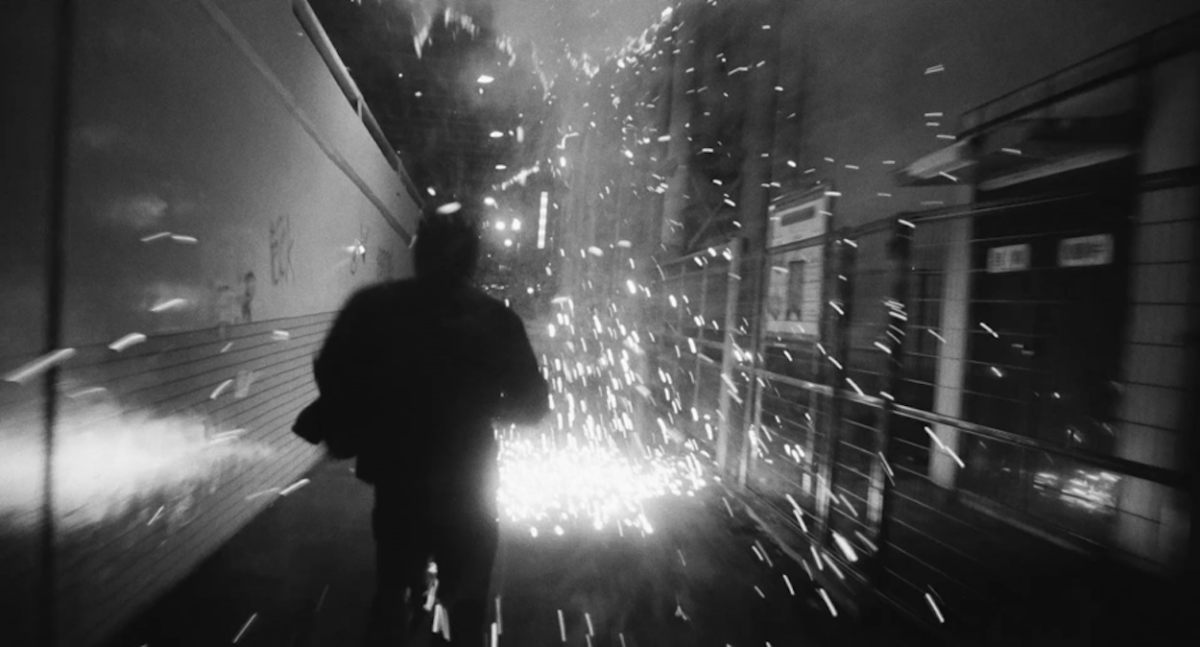
Within Ishii’s filmography, speed is as much attuned to sound, be it that of music or more industrial soundscapes, such as electrical buzzing in Electric Dragon 80.000 V. Himself once a punk musician, Ishii’s sonorous textures are very often influenced by his musical taste: punk, noise or early industrial bands — kinetic genres defined by a relationship with speed and feelings of aggression or dissent. Ishii has equally been a very prolific music video and concert film director (see Halber Mensch, 1986). With that in mind, some of his films, Burst City included, usually also function as vehicles for promoting and collaborating with bands. Ishii’s own noise band MACH-1.67 provided the music for Electric Dragon 80.000 V and the role of Dragon Eye Morrison certainly benefits from Tadanobu Asano’s own qualities as a musician. The Stalin, Kō (Machizo) Machida (associated with INU), The Roosters and the Rockers were all featured in Burst City, as much as they were key actors of the Japanese punk scene around 1980.
With Burst City devised as a concert film in itself, it is the performances that are guiding the tone, as if the film were set to the maniacal shredding of a guitar. The rhythm becomes that of an agitated crowd, where the handheld camera is guided by overexcitement or violence, employing a mosh-pit type of blocking. Music sets the rhythm for some of Ishii’s somewhat calmer films, too, such as Labyrinth of Dreams (1995), which uses a dreamscape soundtrack to communicate an uneasy meditative state. These slower tempo films retain some nuance of erratic movement, even if it isn’t necessarily seen. Aggressive noises of the city — the train tracks, the bus, the crowds — all render the city as an active, busy, stifling place.
Speed and speeding through the city, either by running or by motorcycle, have been a constant in Ishii’s filmography. Even a more recent film like Soredake (2015) opens with a few minutes of being chased through the streets. These actions are often a kind of visual paradox, where the city is equally easily discernible, due to how much of it is geographically represented, and fragmentary, due to how little you can actually pick up. The director’s method of psychogeography is one where the city is experienced in movement and in a rush, always in an altered mental state, be it from euphoria, from experiments (Electric Dragon 80.000 V’s shock therapy), thrill, or dissent, from the adrenaline that comes with trying to escape a follower (see Soredake, Shuffle or the 2003 Dead End Run shorts) or from chemically induced circumstances (the punk gangs in Burst City). It’s mostly aggressive and restless thieves, delinquents and petty criminals that are running through the streets: the two main actions in Ishii’s films are fleeing and charging.
At his most punk, Ishii’s city is depicted through a combination of handheld pans, undercranked montages, shots at street level or mounted onto vehicles that concentrate on the moving road, low angle shots where the city is distorted à la expressionism or shots where the camera is mounted onto the actors. Ishii does opt for more panoramic or architectural views of the city in other films, such as August in the Water (1995) or the shorts from Tokyo Blood (1993). Compare the eerily calm beginning of Angel Dust (1994) with the kinetic flux that opens Burst City. In Angel Dust the city is a concrete, modern, and placeable reality, no more a desolate place, but a bustling metropolis. There is almost an aesthetic pleasure to be derived from these images as the quintessential look of 90s Tokyo. Yet a trace of movement cares to sneak in even here. We end up watching the city from the window of a train, confirming Ishii’s modern experience of the city as something you mostly watch as it goes past.
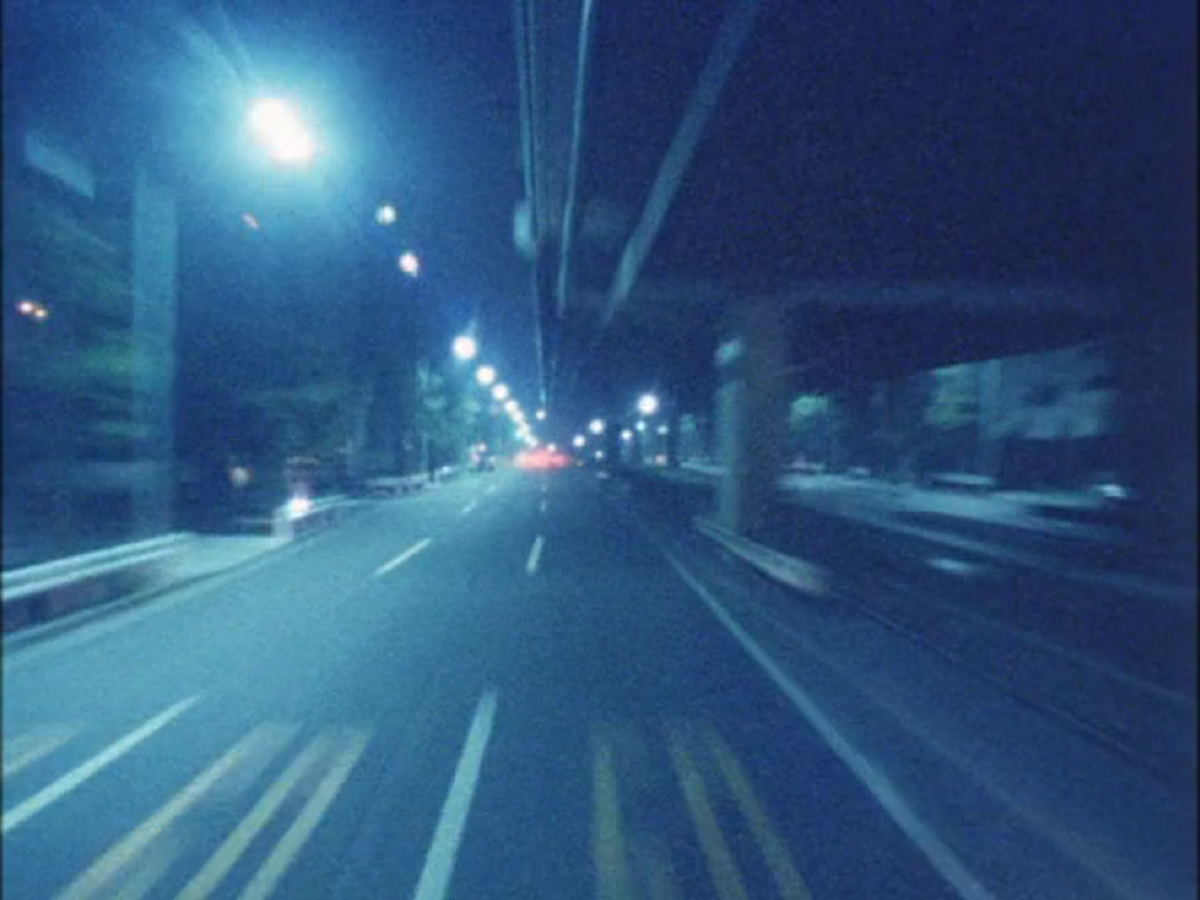
Ishii turned to eco-anxieties and more abstract themes in the 90s, and to characters that are less idiosyncratic in a performative way, as a bōsōzoku would boastfully seek to be. Until returning to his punk aesthetics with Electric Dragon 80.000 V, Ishii’s filmography adopted a quieter tone, as a combination of having trouble financing his more daring projects after the comedy The Crazy Family (1984) and a need to mature or reinvent himself as a filmmaker. Crazy Thunder Road and Burst City look the way they do, after all, not only because they’re a product of a young director at the start of his career, but also because of their production circumstances: low budgets, grainy 16mm stock, improvisation, and experimentation with limited resources and film techniques, as well as a young director at the start of his career. Ishii moving forward to another set of aesthetics may have been just a natural result of him graduating from the independent, self-produced (jishu eiga)‘The Pia Film Festival and Jishu Eiga’, Jasper Sharp, http://www.midnighteye.com/features/the-pia-film-festival-and-jishu-eiga/ roots of his early career.
At that time, anime also seemed to have appropriated a lot of the aesthetics that Ishii was concerned with, and emerging filmmakers like Takashi Miike and the new exploitation genres of V-cinema promised fresh thrills for film audiences. These two forces might have been hard to compete with for Ishii to stick to a (cyber)punk aesthetic. 90s Japan was also marked by the economic bubble bursting, which brought over new anxieties and perhaps the need for the more serious or darker stories that were also reflected in Ishii’s filmography. This is not to say that a film like August in the Water was a dramatic departure from what the director had previously made. Ishii’s 90s films are direct continuation to a film like The Crazy Family in that they focus on another core and returning theme of his filmmaking — illness.
The shift in style, however, also coincides with Ishii’s preferred subcultures losing relevance and momentum by the early 90s. By this time punk wasn’t anymore much of a movement all around the globe, and the music had evolved, or devolved, as some would be happy to argue, into post-punk, noise and other genres. In Japan, too, punk had become more obscureIt certainly didn’t completely disappear (see a band like Balzac), and punk musicians remained active within a changing genre. The second part of the 80s saw, for example, great experiments like Ko Machida’s Wild and Crazy Guys album, but, later on, it was the new, more fragmented subcultures of the 90s that became more popular. or, in some instances, moved closer to heavy metal, glam or darkwave, and gave way to bands like X Japan, Kinniku Shōjo Tai or BUCK-TICK, who still maintained some punk attitudes and visual flair, but lacked the frenetic ethos and charge of previous generations. The bōsōzoku themselves waned in popularity and 80s’ young rebels had to mature into 90s’ salarymen, so to say; the generational rage that marked Ishii’s early films was not solved, but had dissipated.
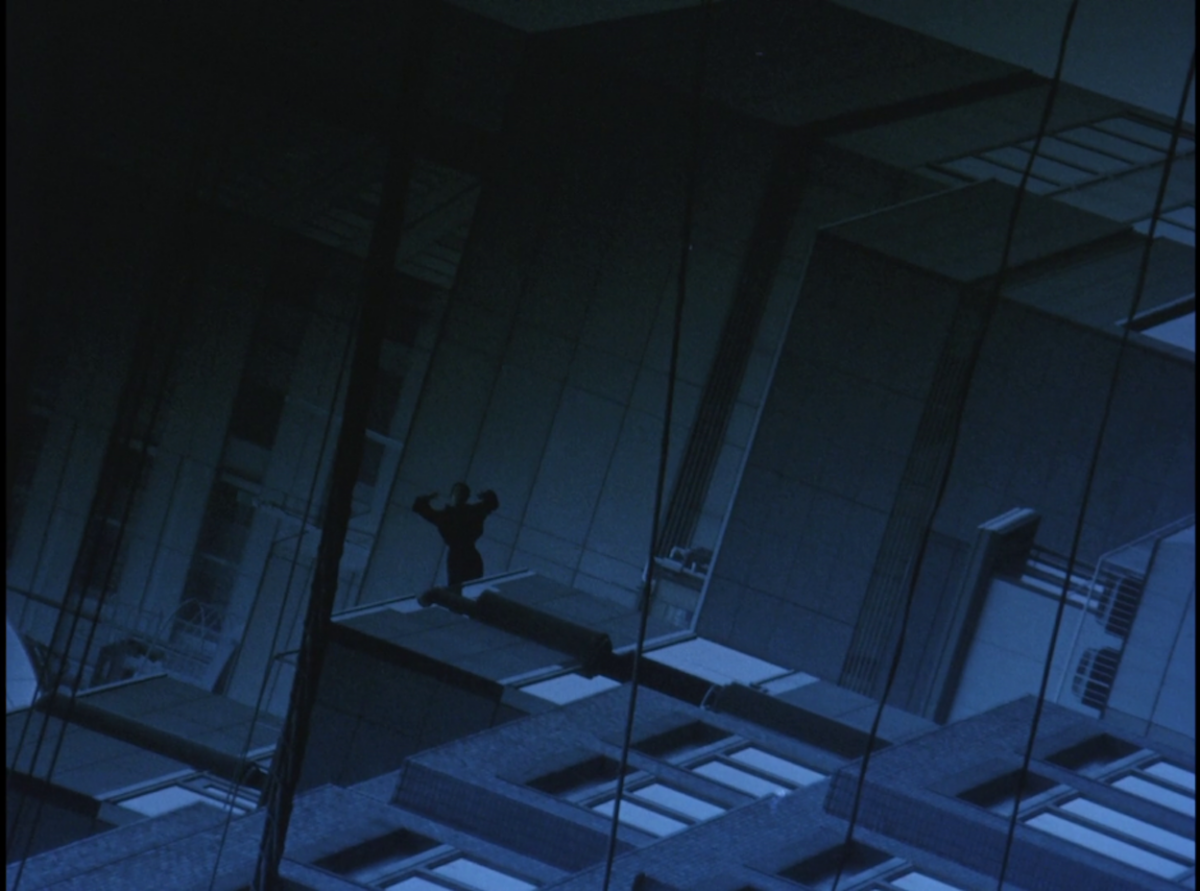
III. Furious & Fast & Fusioned
If Ishii’s urban experience is one that will drive you mad or incite you to rebel, one other filmmaker took this feeling to another, more visceral level. Even if initially influenced by Ishii, Shinya Tsukamoto is credited as even more of a cyberpunk filmmaker, having delivered the two prime cult successes of the genre, Tetsuo: The Iron Man (1989) and Tetsuo II: Body Hammer (1992).
Tsukamoto took from Ishii the undercranking, and turned it into an even grander and perversely cool depiction of technology’s effects on the individual. Ishii’s biker gangs were already preoccupied with altering and customising not only their motorcycles but their bodies, by replacing limbs with pieces of metal or outfitting themselves in steel. Tsukamoto expanded on this, concentrating on technology as a parasitic force par excellence that changes the organic composition of the individual and turns them into a (bloodthirsty) machine.
The Tetsuos are more readily perceived as body horror films, but they, too, are films about movement, speed and the urban landscape. The palpable shock of such an unstable and mind-bending event as a man turning into a disgusting fusion of cables and flesh can only be represented through abnormal speed — a speed reminiscent of the more threatening looking and sounding pieces of technology out there, drills and chainsaws and their industrial kind. For Tsukamoto, these devices also become visual motifs that fascinate and scare through their technological qualities. Take the motif of a penis turning into a drill in the first Tetsuo, that makes a reference to the shared phallic characteristics in shape, but also to the connotations between patriarchal sexuality and violence. This creates a link between technology and deranged sexuality, where both are seen as uncontrollable impulses that turn humans into slaves to their own dark desires. In other words, within the director’s cyberpunk work, technology — both understood as digital technology and as tools or mechanical devices — brings out the worst in humans and is rarely a benign force.
Like Ishii, Tsukamoto uses speed to describe an altered-state exploration of urban space. But Tsukamoto places a greater emphasis on this state as one of modern alienation, resulting from the city becoming a hostile crystal jungle that sends individuals into a frenzy. Compared to its more or less prequel, the second Tetsuo does a more thorough job at describing the city as a glass-windowed hell of tall buildings and mall escalators you rush through. With Tsukamoto, however, anxiety also resides in stillness, as shown by the malaise-inducing shots of Suda travelling home through the city in Tsukamoto’s Tokyo Fist (1995). In this later film, movement, manifested as aggressive boxing, is an escape from the boring salaryman life. Essentially, Tsukamoto’s 90’s cinema is one centred on individual experience, and more concretely on a form of individual rage that needs a kinetic outlet and is enhanced as such on the screen.
The salaryman is also the prototypical protagonist in these films, coming at a time when the bubble economy, which was just about to crash, had warranted new economical and labour anxieties. This centering on the salaryman, and usually on units that he is part of, be it a couple or a family, contrasts with Ishii’s gaze on the bōsōzoku as a subculture and, ergo, a form of collectivity. Ishii’s protagonists in Burst City and Crazy Thunder Road, although they never stand out as individual protagonists, are, crucially, lower class outcasts who either can’t fit in or were rejected by society. Tsukamoto’s salarymen are already part of society, of the system, even if they rather weren’t or struggle with its pressures. If Ishii’s cinema speaks about a rebellious, eccentric youth, Tsukamoto’s films speak more about the anxieties of adults in the workforce.
Yet Tsukamoto’s most interesting representation of movement is the mix of undercranking and stop-motion used throughout the Tetsuo series to show bodily transformations or travelling through the city. This combination creates not a superhuman, but a post-human kind of speed — these metal men don’t need a vehicle to navigate the city anymore, they are the vehicles themselves. Man has become machine. The city is again fragmentary, it exists in the corner of the frame and disappears quickly, although its image remains more visible or present in the second Tetsuo than in the first one. In the second version of the metal men story, the manic protagonist experiments with travelling a bit more adventurously, at one point running perpendicularly on the fronts of buildings. In both films, these journeys are extremely immersive, and set to accelerated industrial music that induces a certain concentrated, but hyper-anxious flow.
The use of stop-action also offers a kind of visual hiccup in speed, rather akin to how a propeller’s real speed won’t be picked up by the camera if it’s in the wrong frame rate. These millimetric breaks in time could, perhaps, be linked to a mechanical or digital lag, even, that further denotes an inorganic sentiment as a principal characteristic of these transformed men. Similar montages can be seen in some more menacing sequences of entrapment or of cables trying to take over bodies, where stop-motion movement is used to instil life into mechanical parts so as to suggest that technology has a life of its own. There’s a worm-like visual quality to these cables, that makes technology look both disgusting and primitive.
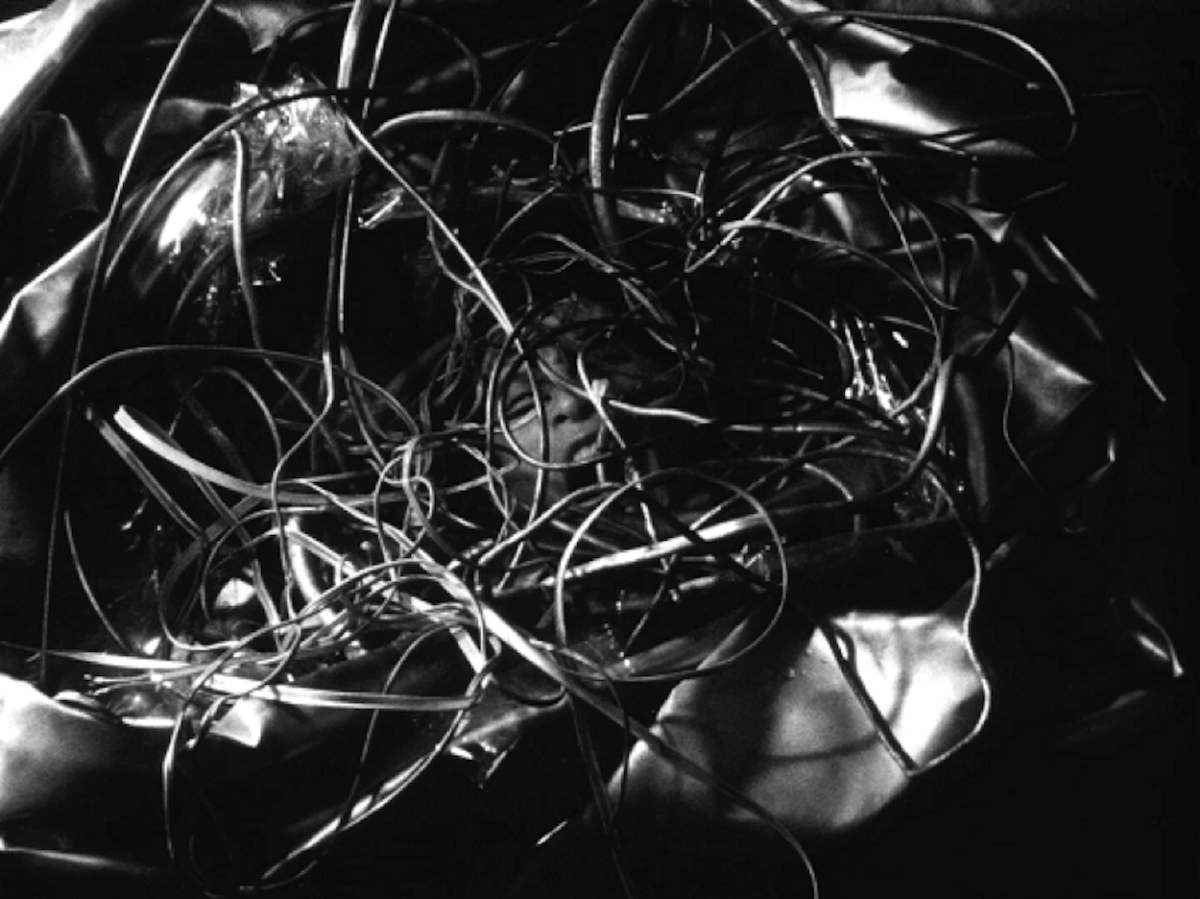
These graphic qualities of undercranked stop-motion are also used for some mnemonic sequences in the Tetsuos, where the main characters are recounting traumatic events from the past, such as an abusive, metal-man father in Tetsuo II. Aided by other, more abstract montages of memories, characters close-ups and uncanny places, these coiling cables pulsing and getting tangled on the screen function like a visual depiction of how trauma might be altering synapses in the brain.
Erratic movement, often as a manifestation of rage, persists in Tsukamoto’s filmography, but these stop-motion montages have not exactly returned in his more recent films. Speed and images of fast surroundings will remain for the director descriptors of an alienating urban life, but with Bullet Ballet (1998), for example, Tsukamoto will also pick up on more lyrical nuances of modern movement. Kirina’s flirting with suicide on the train platform underlines both an eccentric, extreme gesture, but also a plastic, impressionistic beauty of the train running behind her. With Bullet Ballet, Tsukamoto’s speeding trains and cars in tunnels also induce a hypnotic, perhaps sublime, quality of modern examples of movement — rather like how the opening scene in Burst City created a dream image.
IV. Two Tales of Same City
Tsukamoto and Ishii’s contributions to Japanese cyberpunk defined speed, punk motorcyclists, and technology taking over as essential characteristics of the modern urban landscape. The city, the neo-metropolis, became the paradigmatic image of the genre — a crowded space dominated by neon signs, tall buildings, and new gadgets, a space so very often experienced in speed or from a motorcycle, as will show even the genre’s 90s descendants like Ghost in the Shell (1995).
However, even if they are both two of Japan’s most kinetic filmmakers, Tsukamoto and Ishii ultimately treat movement quite differently. Burst City or Electric Dragon 80.000 V are, of course, stricken by bleak projections of the future and societies that have denatured the relationship they have with technology or with each other. And yet, in Ishii’s films speed and movement come more as a thrill or a giddy charge: there is at least some fun to be had when you’re dissenting, that is Ishii’s punk prerogative, and the ample concert scenes in Burst City certainly help with some entertainment. It is actually his films that don’t happen in the underworld and are visually more serene that seem scarier. August in the Water’s calm rhythm and tale about a mysterious illness, meteorites, and the possible end of society feels two times more chilling. On the other hand, Tsukamoto’s films are often about rage and fear channelled into aggressive movement. The Tetsuos are fun, but only for the viewer to watch; their characters experience speed more as a form of torture, as a result of their transformation into inorganic monsters.
Whereas Tsukamoto’s city is dark and suffocating, Ishii’s version of the city is closer to that of the capitalistic ‘neon city’ of the Digital Age, seen as a heterogeneous space defined by hyper-consumption and marked by flashy signs, bustling crowds, and narrow streets. For Ishii, the city is more like a playground—albeit an alienating one—which can induce thrill, if you know how to go about it and are in the right company. The first segment in Tokyo Blood, Street Noise, feels like a sublimation of Ishii’s mix of love and hate for the city, celebrating its colourful aesthetics, while also commenting on its denatured ways of life. Because the bōsōzoku and the punks are more likely to come out at night, Ishii is also a celebrator of jokester resistance and the nightlife, while Tsukamoto tends to be a pessimistic chronicler of daily life. Not to say that Tsukamoto is too sombre or serious, the Tetsuos rely much on comical, cult-ish effects. Ishii, however, is more attuned to a street life as a low-brow experience, and is keener on maintaining a link to popular culture — bands, manga and the like all have directly influenced his filmography, in form and subject.
Like the bōsōzoku, Ishii’s punk films exhibit a degree of devil-may-care carefreeness. Ishii’s idea of movement comes from the same kind of restless energy that punk fed on, and his emergence during the late 70s coincides with a Japanese youth that was transforming its way of expressing dissent. The heights of punk and musical subcultures in Japan also saw the shift from active, militant resistance (see the 60s protesting generation) to a form of general dissatisfaction and desire to disrupt that was anti-establishment, anti-authoritarian, but not always clearly politically aligned. As Japan was discovering new economic stability and new cultural imports, countercultures and subcultures became less radical and embraced a resistance that was more centred on performativity and aesthetics than on organising in the streetsThis is not to say that none of them were political — The Stalin, for example, had great political awareness (even if their name was used more for its shock value), were keen to tour in the Eastern Bloc, and frontman Michiro Endo is also remembered as an activist. Their shows were particularly disruptive. Equally, an album like INU’s Meshi Kuuna! touches heavily on the topic of class.. In turn, the mainstream also embraced more of the avant-garde or at least found a way to make nonconformity more marketable. In this way, Ishii’s trajectory as a filmmaker is closely related to that of punk and Japanese counterculture itself in the 80-90s, and then to its more or less disappearance towards the 2000s.
And yet, what may most importantly set Ishii apart from Tsukamoto is the motorcycle itself. In Burst City and Crazy Thunder Road cars and motorcycles are a prized asset, a promise for thrills and personal freedom, but also a fetish for speed and vehicles. Tsukamoto is not interested in vehicles, but primarily in the body, and only then in movement, while Ishii seeks to often indulge in a visual pleasure of speed, much like what a drifting spectator would also enjoy. Perhaps it’s by no coincidence that the same timeframe that saw the bōsōzoku becoming popular also saw the birth of Japanese drifting. Lest we forget, the 70s were motorcyclist-turned-racer Kunimitsu Takahashi’s (“the father of drifting”) most successful drifting period. A general interest in images of speeding vehicles was already in the air, on all screens and in pop culture, too, that aside from punk and from all the anxieties technology had created.
